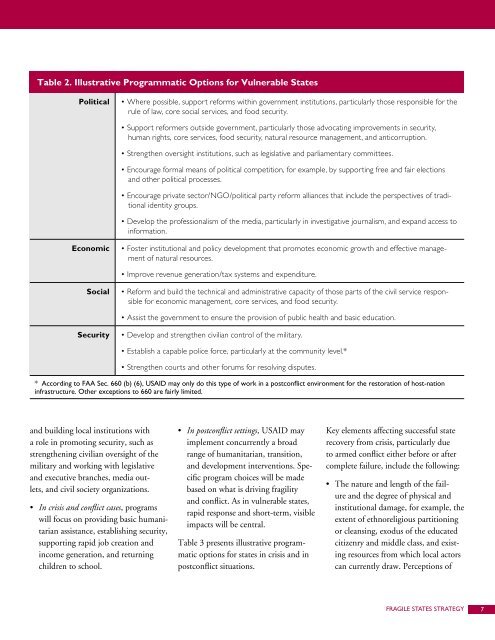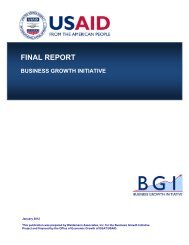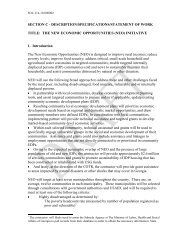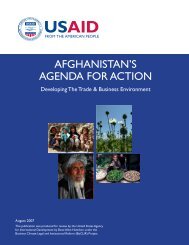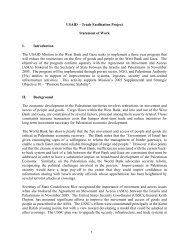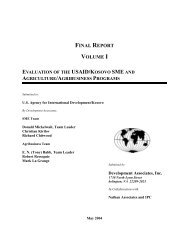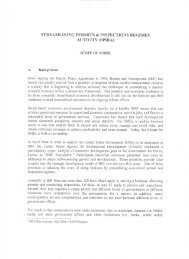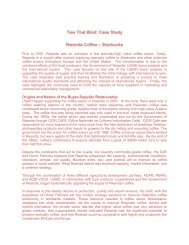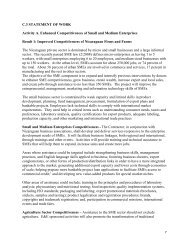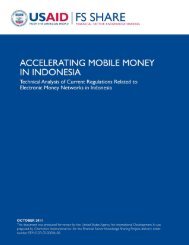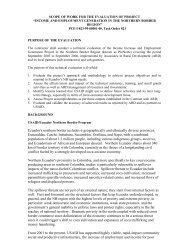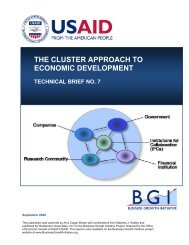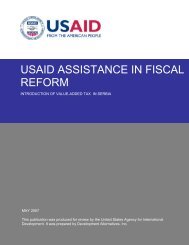tional arrangements that conditionswill be established for stable, longtermgrowth. <strong>The</strong> different impactof fragility on women and menshould also be taken into account.• Seek short-term impact linked tolonger-term structural reform. Experiencedemonstrates that withoutshort-term, visible impact, a fragilesituation is likely to continue todeteriorate. Because those living infragile states cope with instability anduncertainty by focusing on the nearterm, short-term measures are criticalto meeting their immediate needsand promoting an environment ofsecurity. At the same time, the urgentneed for short-term measures shouldalso be considered in the contextof longer-term efforts required toadvance stability, reform, and institutionalcapacity.• Establish appropriate measurementsystems. Expectations are often settoo high for what can be accomplishedin fragile states, and aregeared more toward traditionaldevelopment situations. Accurateassessment of progress and effectivenessin fragile states must be basedon appropriate goals and targets,reflecting realities on the ground.<strong>The</strong>se principles will take differentshapes, depending on whether a state isvulnerable or in crisis.When a state is vulnerable, the strategicfocus will be to prevent crisis and advancerecovery to a stage where transformationaldevelopment is possible.Addressing effectiveness and legitimacyissues will be a priority. <strong>The</strong>se approacheswill be closely coordinatedwith related U.S. Government policyand program initiatives.• Opportunities will likely be greatestwhere effectiveness deficits areparamount. In many cases, <strong>USAID</strong>may want to focus on bolsteringinstitutions, providing essentialsocial services, security, 6 and therule of law. Strengthening healthand education systems, expandingmarkets and economic opportunities,and improving legal systemsare examples of areas where <strong>USAID</strong>has significant experience. Securitydeficits require engaging a broadrange of host-country governmentinstitutions—including the executive,legislative, and judicial branches—aswell as civil society actors and, insome cases, the security forces.• Where legitimacy is an issue, optionsgenerally narrow, and programs oftenshift to nongovernmental and privatesector actors. Indeed, efforts at boostingeffectiveness are unlikely to succeedwithout legitimacy. Where localpolitical will to address legitimacyproblems is lacking, assertive and6 <strong>The</strong> security sector includes the armed forces,the police, judicial and penal institutions, civil servants,and elected and appointed civil authoritieswith responsibility for control and oversight (e.g.,legislative bodies, the executive branch, and civilservants). <strong>The</strong> sector also includes civil societyactors engaged in security issues—such as themedia, watchdog groups, academia, special commissions,community policing, and human rightsgroups and research institutes. Security sectorreform describes the transformation of thesecurity sector to include all these actors workingtogether to manage and operate the sectorin a manner more consistent with democraticnorms and sound principles of good governance.This contributes to a well-functioning securityframework. <strong>The</strong> definition is taken primarily fromthe OECD/DAC’s Security System Reform andGovernance: Policy and Good Practice .effective diplomatic initiatives anddonor coordination will be essentialto send unified messages and coordinateapproaches.Table 2 presents illustrative programmaticoptions for respondingto effectiveness and legitimacy issuesin states that are vulnerable andhighlights political, economic, social,and security priorities. Because thesestates are not yet in crisis, the rangeof program options may look similarto those applied in transformationaldevelopment situations. However,these programs are clearly directed tothe sources of fragility and preventinga slide into crisis.When a state is in crisis, if <strong>USAID</strong> decidesto engage, the strategic focus willbe on stabilizing the situation, mitigatingthe impact of conflict where itexists, and targeting key local actorsto support reforms oriented to whatis driving the crisis. Many postconflictcountries are within the crisis range, dueto their likelihood for returning to conflict.When appropriate, <strong>USAID</strong> willcoordinate closely with S/CRS in thesesettings. If U.S. military forces areengaged, close coordination betweencivilian and military actors is essential.Lack of security plays a particularlycritical role in crisis and postconflictsettings. Achieving some basic levelof stability is often a prerequisite tofurther stabilization and reconstructionefforts and requires coordinationamong all relevant parts of theU.S. Government. <strong>USAID</strong> will workwithin the broader U.S. Governmenteffort, focusing particularlyon supporting community policing6 FRAGILE STATES STRATEGY
Table 2. Illustrative Programmatic Options for Vulnerable <strong>States</strong>Political• Where possible, support reforms within government institutions, particularly those responsible for therule of law, core social services, and food security.• Support reformers outside government, particularly those advocating improvements in security,human rights, core services, food security, natural resource management, and anticorruption.• Strengthen oversight institutions, such as legislative and parliamentary committees.• Encourage formal means of political competition, for example, by supporting free and fair electionsand other political processes.• Encourage private sector/NGO/political party reform alliances that include the perspectives of traditionalidentity groups.• Develop the professionalism of the media, particularly in investigative journalism, and expand access toinformation.Economic• Foster institutional and policy development that promotes economic growth and effective managementof natural resources.• Improve revenue generation/tax systems and expenditure.Social• Reform and build the technical and administrative capacity of those parts of the civil service responsiblefor economic management, core services, and food security.• Assist the government to ensure the provision of public health and basic education.Security• Develop and strengthen civilian control of the military.• Establish a capable police force, particularly at the community level.*• Strengthen courts and other forums for resolving disputes.* According to FAA Sec. 660 (b) (6), <strong>USAID</strong> may only do this type of work in a postconflict environment for the restoration of host-nationinfrastructure. Other exceptions to 660 are fairly limited.and building local institutions witha role in promoting security, such asstrengthening civilian oversight of themilitary and working with legislativeand executive branches, media outlets,and civil society organizations.• In crisis and conflict cases, programswill focus on providing basic humanitarianassistance, establishing security,supporting rapid job creation andincome generation, and returningchildren to school.• In postconflict settings, <strong>USAID</strong> mayimplement concurrently a broadrange of humanitarian, transition,and development interventions. Specificprogram choices will be madebased on what is driving fragilityand conflict. As in vulnerable states,rapid response and short-term, visibleimpacts will be central.Table 3 presents illustrative programmaticoptions for states in crisis and inpostconflict situations.Key elements affecting successful staterecovery from crisis, particularly dueto armed conflict either before or aftercomplete failure, include the following:• <strong>The</strong> nature and length of the failureand the degree of physical andinstitutional damage, for example, theextent of ethnoreligious partitioningor cleansing, exodus of the educatedcitizenry and middle class, and existingresources from which local actorscan currently draw. Perceptions ofFRAGILE STATES STRATEGY 7


